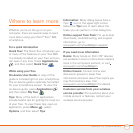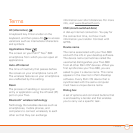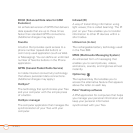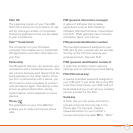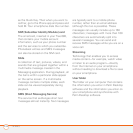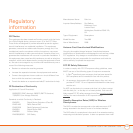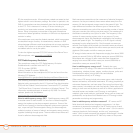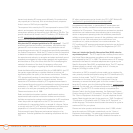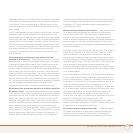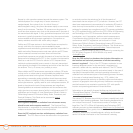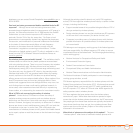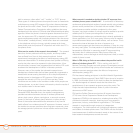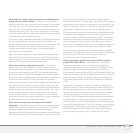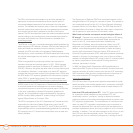
REGULATORY INFORMATION
249
density. Power density is defined as power per unit area. For
example, power density can be expressed in terms of milliwatts (one
thousandth of a watt) per square centimeter (mW/cm2) or microwatts
(one millionth of a watt) per square centimeter (µW/cm2).
The quantity used to measure how much RF energy is actually
absorbed by the body is called the Specific Absorption Rate or SAR.
The SAR is a measure of the rate of absorption of RF energy. It is
usually expressed in units of watts per kilogram (W/kg) or milliwatts
per gram (mW/g).
What biological effects can be caused by RF
energy? The biological effects of radiofrequency energy should not
be confused with the effects from other types of electromagnetic
energy.
Very high levels of electromagnetic energy, such as is found in X-rays
and gamma rays, can ionize biological tissues. Ionization is a process
where electrons are stripped away from their normal locations in
atoms and molecules. It can permanently damage biological tissues
including DNA, the genetic material. Ionization only occurs with very
high levels of electromagnetic energy such as X-rays and gamma
rays. Often the term radiation is used when discussing ionizing
radiation (such as that associated with nuclear power plants).
The energy levels associated with radiofrequency energy, including
both radio waves and microwaves, are not great enough to cause the
ionization of atoms and molecules. Therefore, RF energy is a type of
non-ionizing radiation. Other types of non-ionizing radiation include
visible light, infrared radiation (heat) and other forms of
electromagnetic radiation with relatively low frequencies.
Large amounts of RF energy can heat tissue. This can damage
tissues and increase body temperatures. Two areas of the body, the
eyes and the testes, are particularly vulnerable to RF heating because
there is relatively little blood flow in them to carry away excess heat.
The amount of RF radiation routinely encountered by the general
public is too low to produce significant heating or increased body
temperature. Still, some people have questions about the possible
health effects of low levels of RF energy. It is generally agreed that
further research is needed to determine what effects actually occur
and whether they are dangerous to people. In the meantime,
standards-setting organizations and government agencies are
continuing to monitor the latest scientific findings to determine
whether changes in safety limits are needed to protect human health.
FDA, EPA and other US government agencies responsible for public
health and safety have worked together and in connection with WHO
to monitor developments and identify research needs related to RF
biologicaleffects.
What levels of RF energy are considered safe? Various
organizations and countries have developed standards for exposure
to radiofrequency energy. These standards recommend safe levels of
exposure for both the general public and for workers. In the United
States, the FCC has used safety guidelines for RF environmental
exposure since 1985.
The FCC guidelines for human exposure to RF electromagnetic fields
are derived from the recommendations of two expert organizations,
the National Council on Radiation Protection and Measurements
(NCRP) and the Institute of Electrical and Electronics Engineers
(IEEE). In both cases, the recommendations were developed by
scientific and engineering experts drawn from industry, government,
and academia after extensive reviews of the scientific literature
related to the biological effects of RF energy.
Many countries in Europe and elsewhere use exposure guidelines
developed by the International Commission on Non-Ionizing Radiation
Protection (ICNIRP). The ICNIRP safety limits are generally similar to
those of the NCRP and IEEE, with a few exceptions. For example,
ICNIRP recommends different exposure levels in the lower and upper
frequency ranges and for localized exposure from certain products
such as hand-held wireless telephones. Currently, the World Health
Organization is working to provide a framework for international
harmonization of RF safety standards.
The NCRP, IEEE, and ICNIRP all have identified a whole-body Specific
Absorption Rate (SAR) value of 4 watts per kilogram (4 W/kg) as a
threshold level of exposure at which harmful biological effects may
occur. Exposure guidelines in terms of field strength, power density
and localized SAR were then derived from this threshold value. In
addition, the NCRP, IEEE, and ICNIRP guidelines vary depending on
the frequency of the RF exposure. This is due to the finding that
whole-body human absorption of RF energy varies with the
frequency of the RF signal. The most restrictive limits on whole-body
exposure are in the frequency range of 30-300 MHz where the



